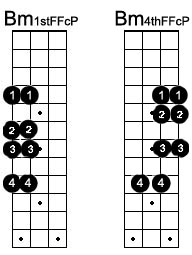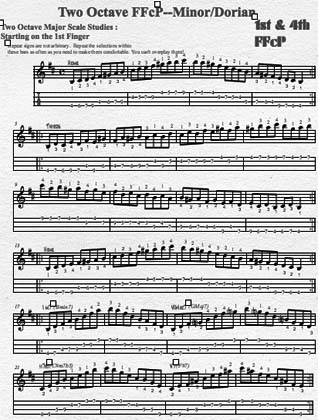« Two Octave FFcP |
Main
| Tips on improvising from the Pros; Will Patton »
 June 21, 2012 | Two Octave FFcP continued June 21, 2012 | Two Octave FFcP continued
Last week, we looked at splicing two FFcP patterns into a two octave drill. We mentioned how these one octave blocks of notes stack nicely and with the 1st FFcP and the 4th FFcP, we have the luxury of not having to shift horizontally up the neck. Not that we want you to stay trapped in one position forever, this is just a good exercise to hone consistency transitioning across the strings. If you are doing it right, you're keeping the palm of your fretting hand from moving around and you're hovering you fingers low and close to the strings for minimum movement even from the G string to the E.
Previous article: Two Octave FFcP
Listen closely as you play, if the sound is not level, strong, and convincing from top to bottom, you need to pay attention to the weak areas--break them down and woodshed them individually. The 3rd/4th finger interchange can be a challenge to even the heartiest FFcP aficionado. When you do master this, you'll find your playing improving in other pieces of music that require long passages across the strings. Worth the investment!
We looked at the Major scale, but there's no reason we can't do the same thing with our Minor/Dorian mode FFcP patterns. We'll move it up a fret and do this week in B minor. This is a great area of the mandolin to play in. The frets are closer together for less stretching, and you have better finger control and flexibility for moving BOTH down and up the fingerboard when you do decide to leave.
Violinist/Mandolinists with their traditional pedagogical background may think this is awkward, especially last week's Bb drills. Rarely do they use the 2nd position fingerings for reasons we won't go into today, but trust us, this is a good skill to have, exploiting the "cheating" frets offer in finger reference. It's something to build on for later.

Start on B on the 4th fret of the G string and move up the fretboard (starting with your first finger), and do two octaves without having to move up the neck. It's perpendicular rather than lateral.
Check it out:  Two Octave FFcP PDF Two Octave FFcP PDF

Further:
FFcP vs Traditional Violin Positions Fingering
Dorian/Minor FFcP
Moving on up. And around.
Left hand hover
FFcP Index
Posted by Ted at June 21, 2012 6:53 AM

Disclaimer: In the 'Information Age' of the 21st Century,
any fool with a computer, a modem, and an idea can
become a self-professed 'expert." This site does not
come equipped with 'discernment.'
|



